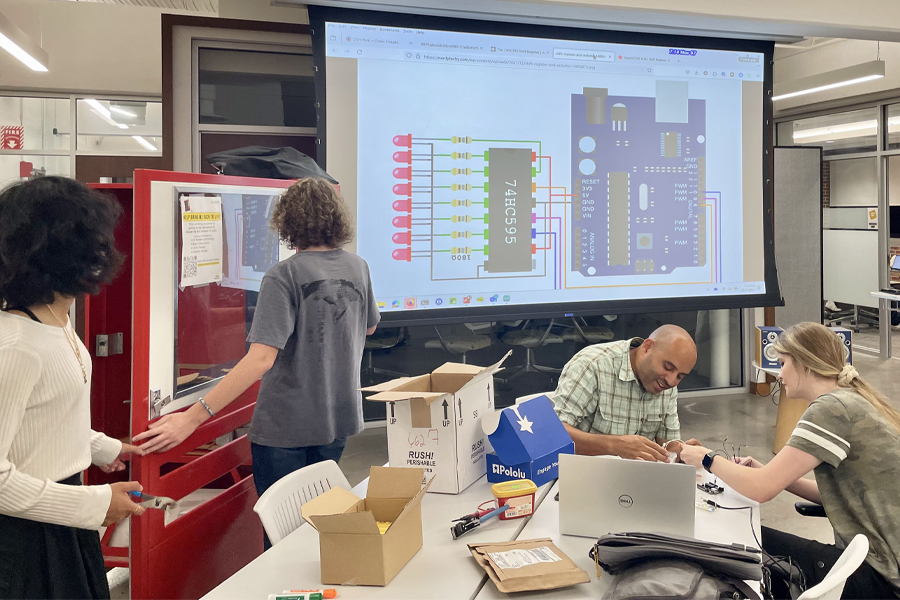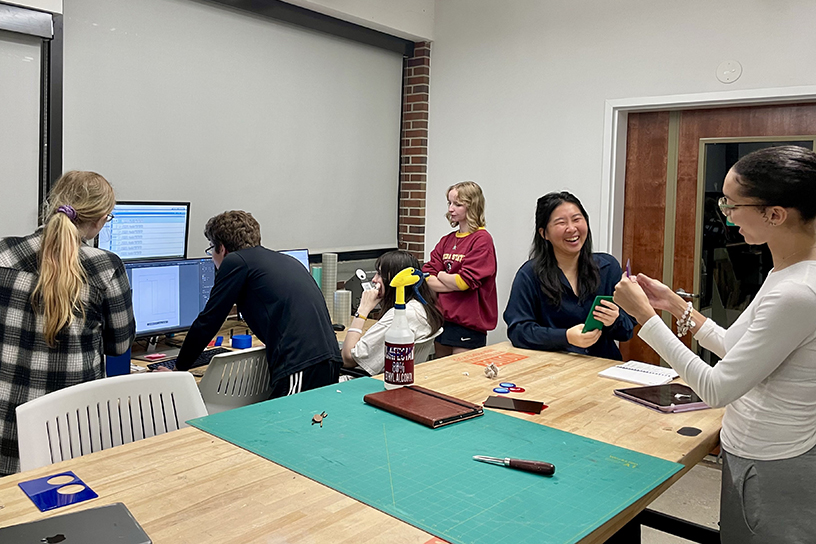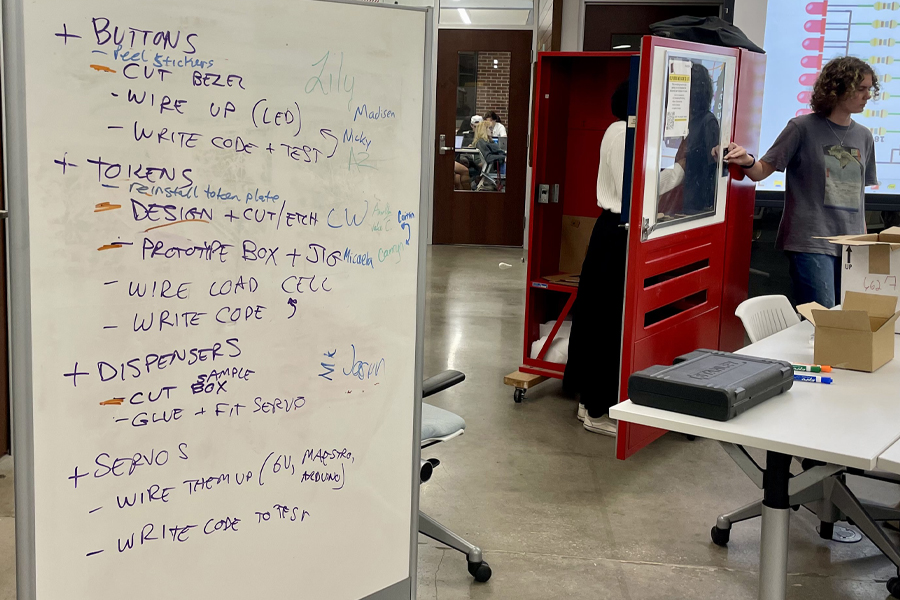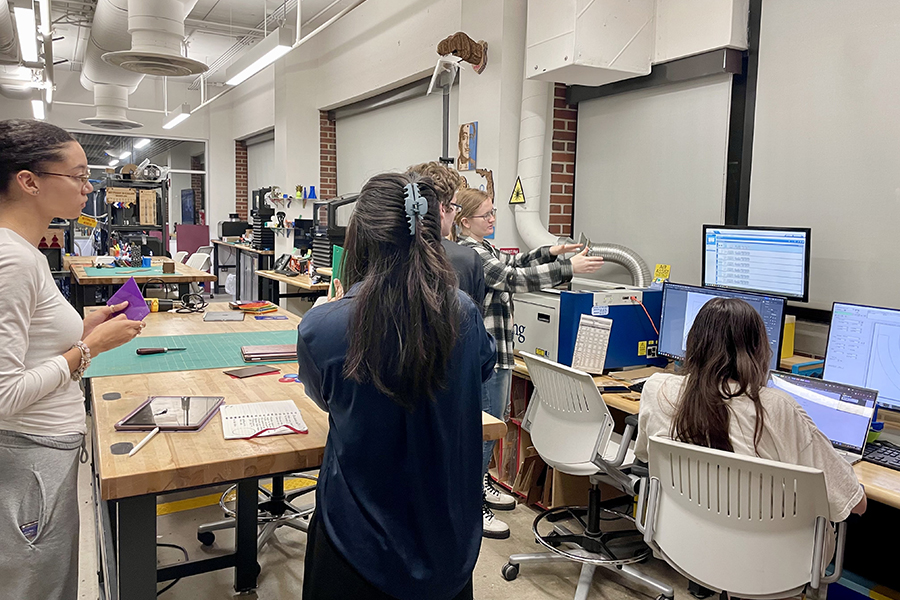
Forget chips and candy bars. An old snack vending machine is getting a new life as a traveling art gallery, thanks to creative students at Florida State University and members of the Thomasville Center for the Arts.
In this interdisciplinary project, students are merging engineering, computer science, design, art and more to dispense miniature masterpieces instead of M&Ms, making art accessible and tangible in an unconventional way.
“Today a lot of interactive art is being digitized, so it’s been rewarding to design and build something that will be experienced physically,” said first-year English major Anna Cheng, a member of Seminole Innovators, a student-led organization dedicated to building valuable skills through collaboration on unique projects such as this.
Under the direction of Associate Professor Rob Duarte of FSU’s Department of Art and Samantha McCoy, Director of Exhibitions at the Thomasville Center for the Arts, students are gaining hands-on experience and applying technical and design skills to reimagine a retro vending machine for pocket sized prints, sculptures, paintings and possibly even art kits.
“We’re not just restoring it; we’re reinventing it.”
— Rob Duarte, associate professor, Department of Art
McCoy, a former FSU Master of Fine Arts student, approached Duarte with the idea last summer. When Duarte learned about Seminole Innovators, he thought it would be a good project for the student group.
“They jumped at the opportunity to help make this vision a reality,” he said.
Acting as both a mentor to the students and a client for the project, McCoy has worked closely with Seminole Innovators to ensure that design elements reflect the Thomasville community. The vending machine will serve as a ‘traveling gallery,’ cycling through museums and arts institutions across Thomasville, Georgia, and showcasing local and student-made art in small formats.
In addition to local student artists, the vending machine will feature artwork from Thomasville-area artists who have carefully considered both creative expression and the practical design of pieces that can withstand the drop into the machine’s collection tray.
“These kinds of restrictions often lead to more creativity,” she said, seeing the size and durability constraints as an opportunity for artists to innovate.

The project brings together FSU students from various majors, including fine arts, engineering, neuroscience, English and advertising, to work at FSU’s Innovation Hub. The Innovation Hub’s mission to encourage cross-disciplinary projects made it the ideal setting for this innovative initiative. The collaborative nature of the project allows students to explore real-world applications of skills such as electromechanics, laser cutting, 3D modeling, embedded systems programming and graphic design.
“This is a chance for art and engineering students alike to explore ideas by working directly with their hands, from sketches and physical models to a finished product,” said Duarte.
Lily Masa, a senior majoring in biomedical engineering and treasurer of the Seminole Innovators, contributed to the art vending machine project through circuitry, coding and design.
“This collaborative project allows me to have a creative outlet that encourages my knowledge of engineering while practicing design with the consumer in mind,” she said.
The vending machine being repurposed is an old snack dispenser, larger and more complex than a traditional Art-o-mat machine, which inspired the idea. Developed in the late 1990s by artist Clark Whittington, Art-o-mat machines repurposed old cigarette vending machines to dispense tiny artwork.
“We’re not just restoring it; we’re reinventing it,” Duarte explained.
The students removed all internal mechanics from their machine and created a fresh electromechanical system to deliver artwork. Students also tackled the challenges of design, mechanical systems and even programming sensors that detect a token’s weight for payment verification.
Adding to the user experience, students envisioned a unique token payment system allowing patrons to purchase custom-made tokens at the museum to use in the vending machine. This development adds another layer of student innovation and creativity while expanding the consumer’s tactile and memorable experience with purchasing art.
“I’ve enjoyed expanding my skills through working with laser cutter technology and engineering the machine’s dispenser to create a piece that I would love to find in a museum,” said Mikayla Long, a senior majoring in cellular molecular neuroscience.

Students have gained exposure to a wide range of tools and techniques while brainstorming together to bring their ideas to life. The student team has been instrumental in making the machine accessible for all users, with a focus on sustainable materials and universally inclusive design.
“Designing for everyone is our aim,” said Duarte, underscoring the project’s emphasis on creating an engaging experience for diverse audiences.
This partnership also continues a long tradition of collaboration between art and engineering fields, evoking historical examples such as Leonardo da Vinci’s fusion of art and engineering and more recent collaborations between contemporary artists and engineers from Google, NASA and elsewhere. For many students, the project offers a rare opportunity to turn theoretical knowledge into practical skills.
“There’s a unique synergy here that reminds me of past collaborations where artists and engineers came together to create groundbreaking work,” Duarte said.
As the team prepares to launch the art vending machine next spring, the machine’s journey to various Thomasville locations promises to bring community members a novel art experience.
“We’re excited to see how the public interacts with the art machine,” said McCoy. “It’s something completely new and a unique way to support local artists in the Big Bend area, we look forward to incorporating artists that are a part of the THOM Collective at the Center for the Arts.”
The project was made possible thanks to the sponsorship of the J. Dell Advancement Group. This one-of-a-kind vending machine exemplifies FSU’s commitment to interdisciplinary learning and community collaboration. The project has not only equipped students with real-world skills but also serves as an innovative bridge connecting the university, artists and the Thomasville community.
Visit the Thomasville Center for the Arts website for more information on exhibitions, and the FSU Innovation Hub website for more information on the Seminole Innovators student organization.





